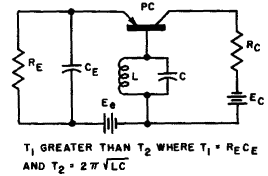| Transistor Basics is a free introductory textbook on transistors and their basic applications. See the editorial for more information.... |

|

Home  Transistor Oscillators Transistor Oscillators  Relaxation Oscillators Relaxation Oscillators  Self-Quenching Oscillator Self-Quenching Oscillator |
||






|
||
|
Self-Quenching OscillatorAuthor: Leonard Krugman
Fig. 6-19. Basic self-quenching oscillator. The relaxation oscillator in combination with the regular base-controlled type can be used to form the self-quenching oscillator. Figure 6-12 (A) illustrates a self-quenching type if the value of either C1 or C2 is increased sufficiently to make the emitter or collector time constant appreciably greater than that of the L-C tank circuit.
 , while the resonant frequency of the tank is , while the resonant frequency of the tank is  . Notice that fQ must be less than fT for proper operation. The basic circuit becomes collector controlled if capacitor CE is moved into the collector circuit. The circuit operation is exactly the same. . Notice that fQ must be less than fT for proper operation. The basic circuit becomes collector controlled if capacitor CE is moved into the collector circuit. The circuit operation is exactly the same.
|
||
Home  Transistor Oscillators Transistor Oscillators  Relaxation Oscillators Relaxation Oscillators  Self-Quenching Oscillator Self-Quenching Oscillator |
||
Last Update: 2010-11-17


